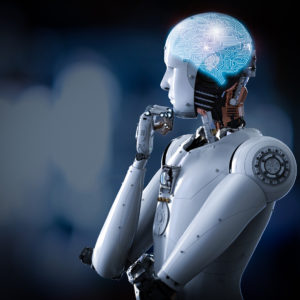The question artificial intelligence (AI), robotics and the future of human work is a Rorschach test: the answer you get depends on what you see. For some, the advent of “smart” everything portends a future of rising living standards and human flourishing. Others see a dark side. Without going “full Terminator,” many of the best informed people in the AI field see a revolution that threatens social cohesion by devaluing human labor.
The actual future will likely contain elements of both these forecasts along with others that we haven’t yet imagined. In the short- and medium-term, significant challenges are probable as artificial intelligence works its way through the economy. The best estimatespredict that somewhere between 10 percent and 30 percent of all jobs — between 15 million and 45 million positions — are susceptible to partial or complete automation in the United States alone.
Moreover, while lower-skilled jobs are at the greatest risk in the short-term, AI is also beginning to affect accounting, medicine, law and, ironically, the high-tech sector itself. The good news is that automation will be gradual and uneven because of its capital costs and implementation challenges.
In the longer term, economic history suggests that substituting technology for human labor is the best path to economic growth and improved living standards. The steam engine that launched the Industrial Revolution eliminated tens of thousands of jobs for artisans producing fine linens — but created millions of factory jobs in textile mills and drove down the price of clothing, and eventually, other wares. Lower prices left more income to purchase new products, devices and services.
This is the triple benefit of innovation: new jobs, lower prices and increased diversity of products. Just as manufacturing replaced agriculture as the principal occupation of Americans, today services and information tasks are replacing manufacturing. Innovation means jobs are destroyed, but new types of work are created at an even faster rate.
Given the pace of change and the degree of uncertainty, what should policymakers — and individuals — do to prepare for the future?
For mid-career workers retraining will be an important part of the solution. Some companies, like AT&T, are investing heavily in skill development programs that help shift their existing workforce into new jobs within the company. AT&T workers who are closer to retirement specialize in maintaining legacy systems using the “old” skills built up earlier in their careers.
Wage insurance is another potentially useful tool for buffering workers against loss of income when higher paid jobs are replaced with more plentiful but lower-paying positions. By partly replacing the income lost during the transition to a new job, wage insurance would help keep more people in the labor force, preventing loss of skills and the physical, psychological and emotional toll of disemployment.
Younger workers face a more complex picture. Since the Sputnik crises of the mid-1950s, presidents, policymakers and educators have emphasized the acquisition of science, technology, engineering and math (STEM) skills. Recent research indicates this may no longer be a good bet for the next generation.
According to one recent study, almost 60 percent of STEM workers leave their careers after 10 years driven out by stagnating wages and obsolete skills. Those with strong inter-personal or noncognitive skills find their way into STEM leadership and management positions. Others have to start over.
This reality is reflected in what employers tell us about what’s missing in our current workforce, namely soft-skills (listening, problem-solving, teamwork, integrity, dependability and adaptability). One study found that when offered the choice between a job candidate with job-specific skills or one who had good general skills, employers favored the general skills by almost two-to-one. Out of a list of eight qualities valued by Google hiring managers, the top seven were soft-skills. You can read more about the soft-skill shortage and strategies for addressing it here.
Finally, remember this: there is no computer that is smarter than the average human being. Algorithms typically do one thing very well. But a human being can do many things well simultaneously. Computers break information down; the human mind integrates information — text, image, sound, body language — creating the thing we call “consciousness,” a feat no computer can replicate. In our high-tech future, people will succeed not by trying to compete with AI but by being more fully human. Ironic, isn’t it?

